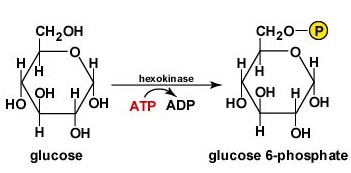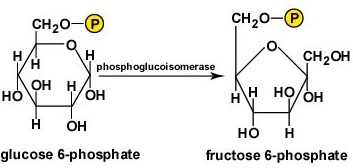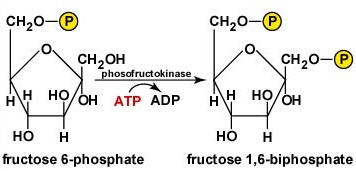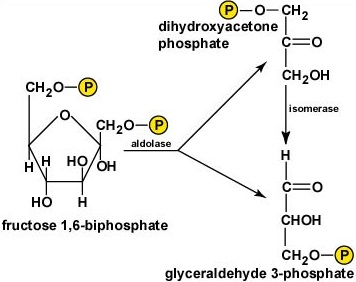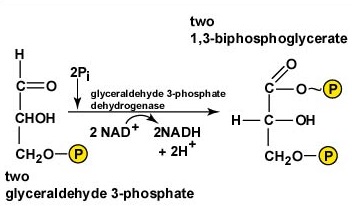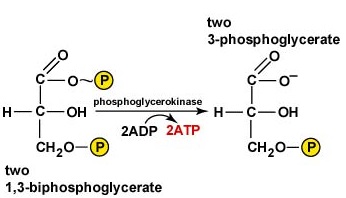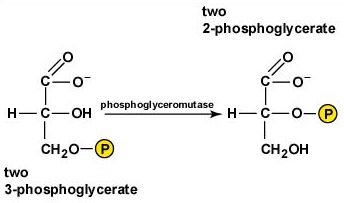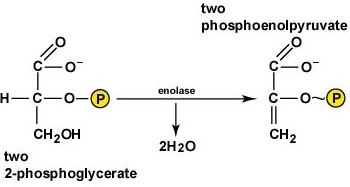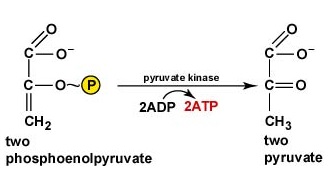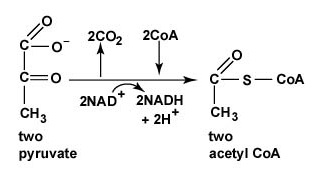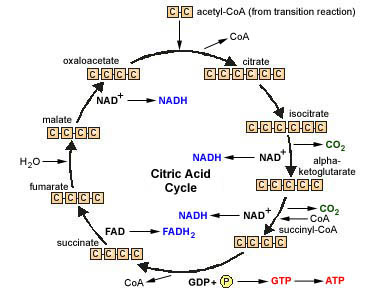Cellular respiration is a set of metabolic reactions that takes place in living organisms to break down glucose into a form that cells can use as energy. There are two main types of cellular respiration, aerobic cellular respiration, and anaerobic cellular respiration. Definitions and cellular respiration equations for both types are given below.
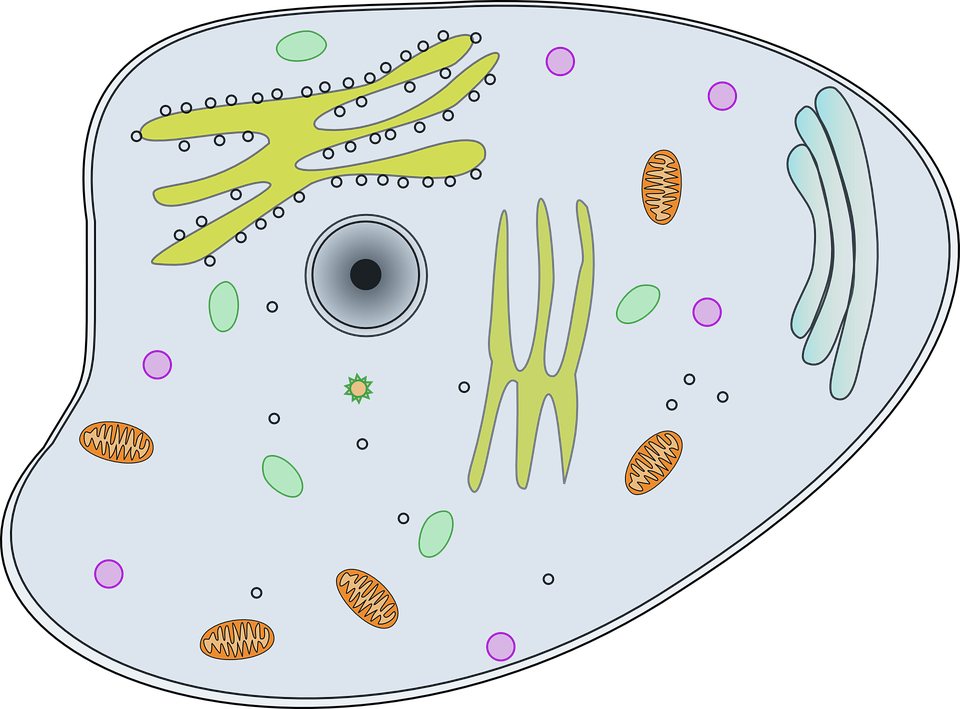
Types of cellular respiration
Aerobic respiration:
Aerobic respiration requires oxygen for the breakdown of glucose.
Aerobic cellular respiration equation:
C6H12O6 + 6O2 → 6CO2 + 6H2O + energy (as ATP)
Anaerobic respiration:
The type of cellular respiration that does not require oxygen is called anaerobic respiration.
It has further two types and cellular respiration equation of both types are given below,
![]() Lactic Acid fermentation:
Lactic Acid fermentation:
C6H12O6 + 2 ADP + 2 pi → 2 lactic acid + 2 ATP
![]() Alcoholic fermentation:
Alcoholic fermentation:
C6H12O6 + 2 ADP + 2 pi → 2 C2H5OH + 2 CO2 + 2 ATP
Aerobic respiration
It is the type of cellular respiration that takes place in the presence of oxygen. In this type, oxygen reacts with glucose to produce energy in the form of ATP. Carbon dioxide and water are the waste product of aerobic respiration.
C6H12O6 + 6O2 → 6CO2 + 6H2O + energy (as ATP)
It has 3 main steps,
![]() Glycolysis
Glycolysis
![]() Krebs cycle
Krebs cycle
![]() Electron transport chain (ETC)
Electron transport chain (ETC)
It also has a transition reaction, known as “oxidative decarboxylation”. This step is a very important connection between glycolysis and the Krebs cycle.
Glycolysis
It is the very first step in the breakdown of glucose to gain energy for the metabolism of the cell. Glycolysis means the breakdown of glucose (glycol; glucose, lysis; breakdown or splitting). Glycolysis is also known as “sugar splitting”. It takes place in the cytoplasm of cells (prokaryotic and eukaryotic) of the living organism. Glycolysis takes place in almost all organisms. All the energy used by living cells is produced by the breakdown of glucose. Glucose can enter the heterotrophic cells by two methods,
![]() Secondary active transport:
Secondary active transport:
In this method, the transport takes place against the glucose concentration gradient.
![]() Facilitated diffusion of glucose:
Facilitated diffusion of glucose:
In this method, a group of integral proteins, GLUT proteins (glucose transporter proteins) are used to carry out the facilitated diffusion of glucose.
There are two main phases of glycolysis, first phase requires energy while the energy is released in the second phase. The second phase also completes the conversion of glucose to pyruvate and following this conversion, the glycolytic pathway is connected with the Krebs cycle and in the Krebs cycle, more ATP is produced to carry out the functions of cells.
The first phase of glycolysis (energy-requiring phase):
In the first phase of glycolysis, two molecules of ATP are used in the phosphorylation of glucose molecules into two three-carbon molecules.
 First step:
First step:
In the first step, an enzyme hexokinase catalyzes the phosphorylation of six-carbon sugars. Hexokinase takes phosphate from ATP molecule and converts glucose into glucose-6-phosphate. This reaction doesn’t allow the glucose-6-phosphate to interact with Glut proteins. Phosphorylated glucose cannot leave the cell because it cannot cross the hydrophobic interior of the plasma membrane due to the negatively-charged phosphate.
 Second step:
Second step:
In the second step, an enzyme isomerase converts the glucose-6-phosphate into fructose-6-phosphate. This conversion of phosphoglucose into phosphofructose is helpful in the formation of two three-carbon molecules.
 Third step:
Third step:
In the third step, an enzyme phosphofructokinase carries out the phosphorylation of fructose-6-phosphate. A phosphate molecule is given from an ATP molecule and added into fructose-6-phosphate to form fructose-1,6-bisphosphate. Phosphofructokinase is a rate-limiting enzyme and it works at a high rate when the amount of ADP is high, it is less active when the concentration of ATP is high. So, if there is a large concentration of ATP in a cell, the reaction is slowed down, since ATP is the end product of the breakdown of glucose reaction.
 Fourth step:
Fourth step:
The fructose-1,6-bisphosphate is converted into dihydroxyacetone-phosphate and glyceraldehyde-3-phosphate with the help of the enzyme aldolase.
 Fifth step:
Fifth step:
In the fifth step, an enzyme isomerase converts the dihydroxyacetone-phosphate into its isomer, glyceraldehyde-3-phosphate. Now two molecules of glyceraldehyde-3-phosphate are present at this step.
At this point in the process, 2 ATP molecules are invested to breakdown 1 glucose molecule.
The second phase of glycolysis (energy-releasing phase):
In the second phase of glycolysis, 4 ATP molecules and 2 higher-energy NADH molecules are formed.
 Sixth step:
Sixth step:
In the 6th step of glycolysis, the two molecules of glyceraldehyde-3-phosphate are oxidized and the energy released by their oxidation is used to add 2 inorganic phosphate molecules into two these oxidized glyceraldehyde-3-phosphate to form two 1,3-biphosphoglycerate (each containing a high energy phosphate bond). During the oxidation of two glyceraldehyde-3-phosphate molecules, 2 ■■■+ are reduced to form two NADH + 2H+.
 Seventh step:
Seventh step:
In the seventh step, phosphoglycerate kinase (an enzyme named for the reverse reaction) converted the two molecules of 1,3-biphosphoglycerate into two 3-phosphoglycerate. 2 phosphate molecules are released which are combined with 2 ADP molecules to form 2 ATP molecules.
 Eighth step:
Eighth step:
In the eighth step, the two phosphate groups of two 3-phosphoglycerate molecules move from third carbon to second carbon and two molecules of 2-phosphoglycerate. This reaction is catalyzed by an enzyme mutase.
 Ninth step:
Ninth step:
This step is a dehydration reaction and is catalyzed by the enolase enzyme. This enzyme removes water from the two molecules of 2-phosphoglycerate. The Double bond is formed in both molecules and the potential energy in the remaining phosphate bonds of both molecule increase result in the formation of two phosphoenolpyruvate (PEP) molecules.
 Tenth step:
Tenth step:
This step is catalyzed by an enzyme pyruvate kinase (named for the reverse reaction of pyruvate’s conversion into PEP). Two phosphoenolpyruvate (PEP) molecules are converted into two pyruvate molecules, 2 high-energy phosphate molecules are released that combined with 2 ADP molecules to form 2 ATP molecules.
Outcomes:
Four ATP, two NADH, and two pyruvate molecules are produced by the breakdown of one glucose molecule.
Summary:
Glycolysis takes place in all living organisms. Glucose is used to produce ATP in living cells. Two molecules of ATP are used to breakdown one glucose molecule. There are two phases of glycolysis, energy is utilized in the first phase and released in the second phase of glycolysis. Different enzymes catalyzed the 10 steps of glycolysis. And four ATP, two NADH, and two pyruvate molecules are produced by the breakdown of one glucose molecule.
Transition reaction (oxidative decarboxylation):
Because this step is an important connection between glycolysis and Krebs cycle, so in this step, two molecules of 3-carbon pyruvate (from glycolysis) are converted into two molecules of 2-carbon acetyl Coenzyme A to enter the Krebs cycle. 2 molecules of carbon dioxide are also produced in this process.
 First step:
First step:
Two carbon dioxide molecules are released into the surrounding medium when the carboxyl group is removed from both pyruvate molecules. Remember that carbon dioxide is the major end product of cellular respiration. Then the two 2-carbon hydroxyethyl groups bound to the two pyruvate dehydrogenase enzymes. So the two carbon molecules are removed from 6-carbon glucose in the shape of 2 molecules of carbon dioxide.
 Second step:
Second step:
The hydroxyethyl groups are oxidized to acetyl groups. Electrons are added to up 2■■■+ to form 2NADH that is the reduced form of ■■■+. These high-energy electrons of 2NADH will be used later to generate ATP in the cell.
 Third step:
Third step:
The enzyme-bound two acetyl groups are converted into two Coenzyme A, which produced two molecules of acetyl Coenzyme A. The two acetyl Coenzyme molecules are ready to enter the Krebs cycle.
 Reaction for all the three steps:
Reaction for all the three steps:
![]() The equation for oxidative decarboxylation:
The equation for oxidative decarboxylation:
2 pyruvate + 2 ■■■+ + 2 coenzyme A → 2 acetyl-CoA + 2 NADH + 2 H+ + 2 CO2
In prokaryotic cells, oxidative decarboxylation takes place in the cytoplasm. While in the eukaryotic cell, the oxidative decarboxylation takes place in mitochondria because the Krebs cycle takes place in the matrix of mitochondria.
Summary:
It is a transition reaction for the conversion of pyruvate molecules into acetyl Coenzyme A. This is an important reaction between glycolysis and the citric acid cycle (Krebs cycle). 2 molecules of carbon dioxide are produced that are the major end product of aerobic cellular respiration. Oxidative decarboxylation takes place in the cytoplasm of prokaryotic cells and the mitochondrial matrix of eukaryotic cells.
Krebs cycle
Krebs cycle is also called the citric acid cycle or the tricarboxylic acid cycle. It takes place in the mitochondrial matrix. All the enzymes that catalyzed the Krebs cycle are soluble in water except one that is succinate dehydrogenase and it is embedded in the inner membrane of the mitochondrion. The Krebs cycle is a close loop, which means that the last step of the Krebs cycle regenerates the compound used in the first step. The Krebs cycle has eight steps which are the series of redox, dehydration, hydration, and decarboxylation reactions.
 First step:
First step:
It is a condensation reaction. The 2-carbon acetyl group that is released from acetyl Coenzyme A is combined with a 4-carbon oxaloacetate molecule. In this way, 6-carbon molecule citrate is produced. Coenzyme A is combined with sulfide group (-SH) and diffuses away to react with other acetyl groups. It is a highly exergonic (in which there is a positive flow of energy from the system to the surroundings) step therefore, it is an irreversible reaction. If there is a low amount of ATP, the rate of reaction increases. If ATP is present in a large amount, the rate of reaction decreases.
 Second step:
Second step:
In this step, first, the citrate loses one molecule of water and then adds up one molecule of water. In this way, citrate regenerates to form its isomer, isocitrate.
 Third step:
Third step:
It is an oxidation and decarboxylation step. In the third step, isocitrate is oxidized and a molecule of carbon dioxide is removed from it that results in the production of a 5-carbon molecule alpha-ketoglutarate. ■■■+ is reduced to NADH and H+ in this oxidation. This reaction is also regulated by negative feedback from ATP and NADH and positive feedback from ADP.
 Fourth step:
Fourth step:
It is a decarboxylation and oxidation step. In this step, alpha-ketoglutarate is oxidized and carbon dioxide is removed. A Coenzyme A is added to alpha-ketoglutarate to form a 4-carbon compound succinyl-CoA. ■■■+ is reduced to NADH and H+ in this oxidation. The enzyme that catalyzes this step is regulated by the negative feedback of ATP.
 Fifth step:
Fifth step:
CoA is removed from succinyl-CoA and phosphate is added to it that results in the formation of succinate. A high-energy bond is formed between the succinate and phosphate groups. GTP is produced in this reaction by the phosphorylation of GDP. Sometimes ATP is produced depending upon the type of animal tissues. There are two types of enzymes in this reaction, one type is carried out by the production of ATP, and the other helps in the formation of GTP.
![]() If this reaction takes place in the tissues of the heart and skeletal muscle then ATP is produced because the heart and skeletal muscle require a large amount of ATP for their function.
If this reaction takes place in the tissues of the heart and skeletal muscle then ATP is produced because the heart and skeletal muscle require a large amount of ATP for their function.
![]() If this reaction takes place in liver tissues, where there are more anabolic pathways, GTP is produced. GTP is equal to ATP in energy but its use is more restricted. In some cases, GTP is converted into ATP.
If this reaction takes place in liver tissues, where there are more anabolic pathways, GTP is produced. GTP is equal to ATP in energy but its use is more restricted. In some cases, GTP is converted into ATP.
 Sixth step:
Sixth step:
It is a dehydration step. Succinate is converted into fumarate. Two atoms of hydrogen are combined with FAD to form FADH2. The energy produced in this reaction is inadequate to reduce ■■■+ but sufficient to reduce FAD into FADH2. This step is catalyzed by the enzyme that is embedded in the inner membrane of the mitochondrion. FADH2 remains attached to the enzyme and transfers the electrons to the electron transport chain directly.
 Seventh step:
Seventh step:
Water is added to fumarate which results in the formation of malate.
 Eighth step:
Eighth step:
Malate is oxidized to form oxaloacetate. It is the starting product of the Krebs cycle. ■■■+ is reduced to NADH and H+ in this oxidation.
Outcomes of Krebs cycle:
Two carbon dioxide molecules, one GTP/ATP, three molecules of NADH, and one molecule FADH2 are produced in the citric acid cycle or Krebs cycle. NADH and FADH2 molecules are the carriers that connect with the last portion of aerobic respiration to produce ATP molecules. The Krebs cycle is amphibolic (both catabolic and anabolic) because different intermediate compounds of the Krebs cycle are used to synthesize non-essential amino acids.
Summary:
Krebs cycle is also known as the citric acid cycle or tricarboxylic acid cycle. It consists of eight steps and it is a closed-loop process. Different enzymes are used to catalyze the Krebs cycle. Krebs cycle is an amphibolic process.
Electron transport chain
Electron transport chain the last and final step of aerobic respiration and this part uses atmospheric oxygen. The electron transport chain resembles a relay race because it is a series of redox reactions in which the electrons are passed from one component to the next to the endpoint of the chain where they produce water by reducing molecular oxygen. The electron transport chain releases energy in the form of ATP.
 First step:
First step:
NADH and FADH2 are oxidized and release high-energy electrons and protons. These electrons are transferred to the electron transport chain with the help of transmembrane carrier proteins. The electrons lose their energy by passing through the chain and this energy is used to pump H+ ions between two parts of the mitochondria to establish and maintain a concentration gradient (proton motive force).

 Second step:
Second step:
H+ ions move down to electrochemical gradient and diffuse back into the matrix and this is caused by proton motive force. This diffusion of the protons is known as chemiosmosis and it is facilitated by the ATP synthase enzyme. By the movement of H+ ions through ATP synthase , H+ ions trigger the molecular rotation of the enzyme, synthesizing ATP

 Third step:
Third step:
For the proper and complete functioning of the electron transport chain, the electrons of low energy must be removed. Oxygen removed these low-energy electrons and prevents the chain from being blocked. Oxygen also maintained the hydrogen gradient by combining with free protons and forming water. Hydrogen carriers cannot transfer high-energy electrons to the chain and ATP production is halted in the absence of oxygen.

Summary:
The electron transport chain is the final step of aerobic respiration and it resembles the relay race. It has a series of redox reactions. Energy is formed at the end of ATP.
Anaerobic respiration:
As the name shows, it takes place in the absence of oxygen. It is also a type of cellular respiration in which glucose is broken to produce energy in the absence of oxygen.
Lactic acid fermentation and alcoholic fermentation are the two main types of anaerobic respiration,
Lactic acid fermentation:
In this type, glucose is converted into two molecules of lactic acid to produce ATP. The ■■■■■■■ dehydrogenase (LDH) enzyme carries out lactic acid fermentation. This type of fermentation is carried out by different mammalian cells, red blood cells, and skeletal muscle that has an inadequate supply of oxygen to carry out aerobic respiration. The reaction of lactic acid fermentation can proceed in both directions but the reaction from the left-right direction is inhibited by some acidic conditions. It occurs in some bacteria and some animal tissues i.e, muscle tissues.
Equation:
C6H12O6 + 2 ADP + 2 pi → 2 lactic acid + 2 ATP
Sore muscle and lactic acid fermentation:
Our muscles use oxygen to produce ATP faster than the supply of oxygen during tough exercises. In this case, muscle cells perform glycolysis at a higher rate than the supply of oxygen to the mitochondrial electron transport chain that results in anaerobic respiration and lactic acid fermentation start in our muscle cells. when we exercise for a long time then lactic acid is accumulated in our muscles and makes our muscles sore.
Alcoholic fermentation:
Glucose is converted into ethanol or ethyl alcohol in alcoholic fermentation. This type of fermentation takes place in yeast and some type of fishes such as goldfish.
Equation:
C6H12O6 + 2 ADP + 2 pi → 2 C2H5OH + 2 CO2 + 2 ATP
Other types of fermentation:
Different methods of fermentation are used by other organisms to ensure a sufficient supply of ■■■+ for the sixth step in glycolysis. Because without this step, no ATP can form. Other fermentation methods are performed by some bacteria and archaea. Butyric acid fermentation, propionic acid fermentation, butanediol fermentation, methanogenesis, acetogenesis, and Stickland fermentation are other types of fermentation. All forms of fermentation produce gas except lactic acid fermentation.
Aerobic and anaerobic respiration
Differences:
![]() During aerobic respiration, most of the reactions are taking place in mitochondria. The membranes of mitochondria make this process more efficient because all the reactants of this process are in the small space of mitochondria.
During aerobic respiration, most of the reactions are taking place in mitochondria. The membranes of mitochondria make this process more efficient because all the reactants of this process are in the small space of mitochondria.
In contrast,
Anaerobic respiration takes place in the cytoplasm of the cells of all living organisms. This is because the cells that carry out anaerobic respiration have not specialized organelle for anaerobic respiration. There is short series of reactions in anaerobic respiration.
![]() Aerobic respiration produces a large amount of energy in the form of ATP.
Aerobic respiration produces a large amount of energy in the form of ATP.
In contrast,
Anaerobic respiration produces less amount of ATP for each digested sugar molecule, this makes it a less efficient process as compared to aerobic respiration. It also produced several waste products such as alcohol.
Similarities:
![]() Both aerobic and anaerobic respiration are forming energy by the breakdown of sugar molecules. Aerobic and anaerobic respiration starts with the breakdown of a six-carbon sugar molecule (glucose) into 2 three-carbon pyruvate molecules in a process called glycolysis. This process used two ATP molecules and forms four ATP molecules.
Both aerobic and anaerobic respiration are forming energy by the breakdown of sugar molecules. Aerobic and anaerobic respiration starts with the breakdown of a six-carbon sugar molecule (glucose) into 2 three-carbon pyruvate molecules in a process called glycolysis. This process used two ATP molecules and forms four ATP molecules.
![]() In both aerobic and anaerobic respiration, the two pyruvate molecules are used to start another series of reactions that use electron transport chains to generate more ATP molecules.
In both aerobic and anaerobic respiration, the two pyruvate molecules are used to start another series of reactions that use electron transport chains to generate more ATP molecules.
![]() Humans and other animals carry out aerobic respiration to stay alive, but they can also be modified their cells to carry out anaerobic respiration in the absence of oxygen.
Humans and other animals carry out aerobic respiration to stay alive, but they can also be modified their cells to carry out anaerobic respiration in the absence of oxygen.
Types of organisms based on the availability of oxygen
Organisms are classified based on the availability of oxygen.
 Obligate aerobes:
Obligate aerobes:
Obligate aerobes organisms cannot survive in the absence of oxygen
For example: Human beings.
 Obligate anaerobes:
Obligate anaerobes:
Obligate anaerobes cannot live in the presence of oxygen.
For example: Certain species of bacteria such as Clostridium tetani cause tetanus.
 Aerotolerant organisms:
Aerotolerant organisms:
These organisms can live in the presence of oxygen but don’t use oxygen for their growth.
For example: Streptococcus bacterium which causes Strep throat.
 Facultative aerobes:
Facultative aerobes:
These organisms use oxygen for their growth but also carry out anaerobic respiration in the absence of oxygen.
For example: Saccharomyces cerevisiaecerevisiae and the yeast used in brewing.
Summary:
Anaerobic respiration is a type of cellular respiration in which glucose is broken in the absence of oxygen. Lactic acid fermentation and alcoholic fermentation are types of lactic acid fermentation. Some other types of fermentation are also carried out by some bacteria and archaea. There are some differences and similarities between aerobic and anaerobic fermentation. Organisms are classified based on the availability of oxygen.
Misconceptions about cellular respiration
 Anaerobic respiration is different from cellular respiration:
Anaerobic respiration is different from cellular respiration:
Some people believe that anaerobic respiration is different from cellular respiration but indeed anaerobic respiration is a part of cellular respiration. Glycolysis is an anaerobic step of all types of cellular respiration. If the oxygen is present, then the glycolysis followed the citric acid cycle via oxidative phosphorylation but when the oxygen is not present then some organisms start fermentation to produce ATP.
 Plants cannot go cellular respiration:
Plants cannot go cellular respiration:
It is a very common misconception. Many people believe that animals undergo cellular respiration and plants carry out photosynthesis. But this is wrong because plants do both. Plants carry out photosynthesis to form glucose and then they undergo cellular respiration because glucose is very important to start cellular respiration. While animals don’t undergo photosynthesis because they already get their glucose from the food they eat.
 Cellular respiration and breathing are the same:
Cellular respiration and breathing are the same:
It is another common misconception and it is a little bit confusing. People used the word respiration of inhaling and exhaling but this inhaling and exhaling are the parts of breathing. Respiration is a different process. Both are related but are not the same.
Frequently asked questions (FAQs)
Here are some frequently asked questions about cellular respiration.
1. What product of photosynthesis is used to start cellular respiration in the plant?
Photosynthesis is the process of forming sugar (glucose) by using sunlight. The major end product of photosynthesis is glucose and it is used to start cellular respiration.
2. What are the advantages of ATP?
ATP is a small and soluble molecule that can be easily broken down. Energy is released by the breakdown of ATP and this energy is used to carry out all the life activities of the cells of living organisms.
3. Is gluconeogenesis is the reverse process of glycolysis?
Glucose is converted into pyruvate in glycolysis and pyruvate is converted into glucose in gluconeogenesis. But gluconeogenesis is not the reverse process of glycolysis because it has many reactions which are different from glycolysis.
4. After glycolysis, pyruvate can be converted into which different products?
After the formation of pyruvate in glycolysis, pyruvate can be converted
![]() Into carbohydrates by gluconeogenesis
Into carbohydrates by gluconeogenesis
![]() Into acetyl Coenzyme A, to start the citric acid cycle
Into acetyl Coenzyme A, to start the citric acid cycle
![]() Into amino acid alanine
Into amino acid alanine
![]() Or into alcohol.
Or into alcohol.
5. What is the irreversible step of glycolysis?
The phosphorylation of fructose 6-phosphate to fructose 1,6-bisphosphate is the irreversible step of glycolysis. It a unique step of the glycolytic pathway.
6. What is the main difference between aerobic and anaerobic cellular respiration?
Aerobic cellular respiration takes place in the presence of oxygen and anaerobic cellular respiration carries out in the absence of oxygen. This is the main difference between aerobic and anaerobic cellular respiration.
7. What is the complete equation for aerobic cellular respiration?
Complete equation for aerobic cellular respiration is given below,
C6H12O6 + 6O2 → 6CO2 + 6H2O + energy (as ATP)
8. Do fungi carry out cellular respiration?
Yes, fungi also carry out cellular respiration to convert their organic molecules, fats, and carbohydrates, into energy in the form of ATP.
9. Do protists carry out cellular respiration?
![]() Animal-like protists carry out cellular respiration.
Animal-like protists carry out cellular respiration.
![]() Plant-like protists can carry out photosynthesis and then cellular respiration.
Plant-like protists can carry out photosynthesis and then cellular respiration.
![]() Fungi-like protists carry out either aerobic or anaerobic respiration.
Fungi-like protists carry out either aerobic or anaerobic respiration.
![]() Unicellular protists rely on diffusion.
Unicellular protists rely on diffusion.
10. Is the process of glycolysis is endergonic or exergonic?
Glycolysis has both endergonic and exergonic steps. However, the overall process is exergonic with a large decrease in free energy.
Conclusion:
Cellular respiration is the process of generating energy by the breakdown of a 6-carbon sugar molecule (glucose). Cellular respiration is of two types. Anaerobic and aerobic. Aerobic cellular respiration is carried out in the presence of oxygen and its cellular respiration equation is C6H12O6 + 6O2 → 6CO2 + 6H2O + energy (as ATP). Aerobic respiration has three main steps, glycolysis, Krebs cycle or citric acid cycle, and electron transport chain. Aerobic respiration also has a transition step known as oxidative decarboxylation of pyruvate and this step is the major connection between glycolysis and the Krebs cycle. While the anaerobic respiration is carried out in the absence of oxygen and it has further 2 types, lactic acid fermentation and alcoholic acid fermentation. some bacteria carried out some other types of fermentation.organisms are divided on the basis of availablity of oxygen.
